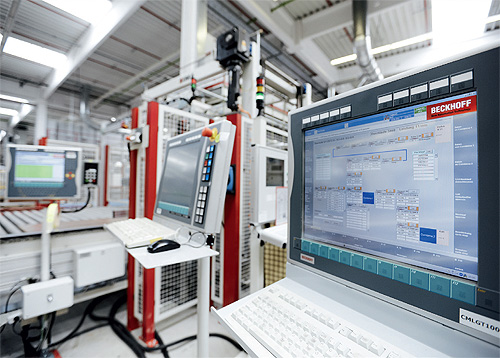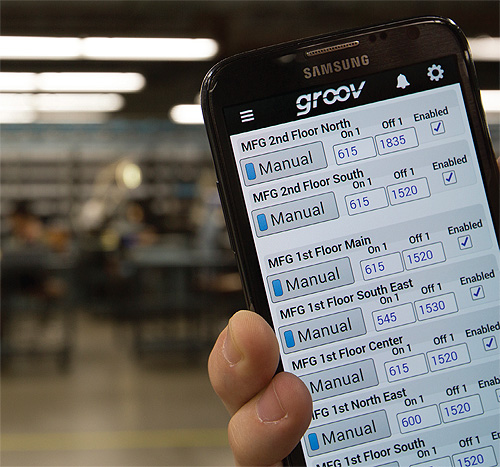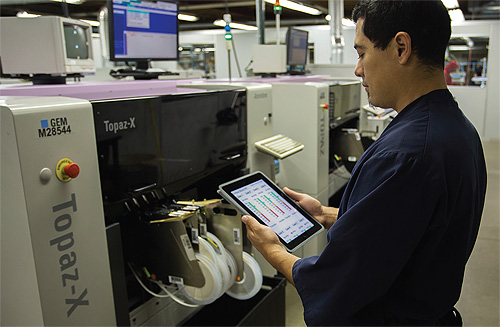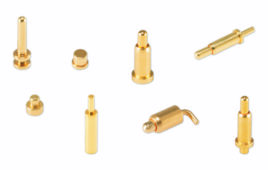by Leslie Langnau, Managing Editor
The latest development of industrial Ethernet is how it will be a part of the Industrial Internet of Things (IIoT). Variations of Ethernet still abound, yet some of the conversation is moving toward accepting the open Ethernet standard, a variation developed by Mellanox Technologies. Open Ethernet is targeted more at IT use, and is being evaluated by IT departments in many companies. It is not widely used in industrial applications yet.
Ten years ago, many industrial companies had Ethernet connectivity and distributed intelligence. “The infrastructure was in place,” said John Kowal, director, business development at B&R Automation. “What we will see now, with IIoT as a strategic business imperative, is an expansion of demand and of commercialized applications to make use of all this connected, distributed intelligence.”
For many suppliers of industrial HMI devices and controllers, web servers have long been a standard feature. But some companies are now realizing that these features enable IIoT, and they are beginning to use this capability.
“Ten years ago we didn’t have the level of secure communications commercially available,” continue
“There were smart sensors back then too, but users didn’t want to add $100 to a photo-eye that they expected to get hit by a lift truck. Now, distributed intelligence is cheaper, more accessible, and therefore going into devices like vision sensors, I/O slices and stepper drives in remote I/O form factor, whereas in the past the cost justification stopped at the high end servo drive level,” he said.
The IIoT is an evolution of the connectivity efforts started years ago. As Daymon Thompson, TwinCAT product specialist, Beckhoff Automation, noted, it is a concept that will only be fully implemented in the coming 10 to 20 years.
Even so, manufacturing operations are taking advantage of the evolution of Ethernet into the IIoT. Here are a few examples.
Packaging
AutomationDirect was instrumental in helping a packaging manufacturer develop a control and data collection system in its plants. A key requirement was to have plant information and statistics available to management from anywhere in the world on a 24/7 basis. The AutomationDirect C-more HMI product was chosen for this application. It has a built-in FTP server to serve production statistics out to the Web in real time. It can also send HMI screen captures. It enabled management to look at a predefined set of operator screens as well as a full set of production statistics from anywhere in the world. Said Gary Marchuk, director of business development at AutomationiDrect, “As technologies continue to drive data to the Cloud, we see the need for these types of applications growing at a more rapid pace.”
This application was made possible through the use of standard Ethernet as the communication medium for the HMI and PLC.
Simpler sensor connection
Noted Shishir Rege, marketing manager networking and safety, Balluff, implementing a smart device was a time consuming, expensive and cryptic operation. “Maintaining such installations was a nightmare.”
With the advent of industrial Ethernet and device communication standards like IO-Link, integration of smart devices becomes simple. Parameterization, predictive diagnostics and overall functionality of sensors got a big boost. Now, instead of finding the cheat-sheets of parameters to configure a smart sensor in the middle of the night, it now becomes a matter of finding the replacement sensor and simply plugging it in. The control systems incorporating industrial Ethernet technologies with IO-Link automatically configure the device to the correct parameter setting.
Lot sizes of 1
Nobilia manufactures an enormous number of kitchens per year, with over 580,000 produced in the two manufacturing plants located in Verl in East Westphalia, Germany. Around 2,600 custom kitted kitchens leave Nobilia’s two production plants every day.
PC-based control from Beckhoff is the foundation for the universal transparency of the parts and production data needed to allow individual kitchens to be supplied flexibly and efficiently in a lot size of 1, which is entirely in keeping with the ideals of Industry 4.0. Modern Industry 4.0 concepts, and the higher flexibility in production that is attainable with them, are not possible without ensuring transparency of all machine and parts data.
Real-time tracking capability over the entire process is the fundamental requirement. For Nobilia, it starts by applying a barcode label that contains all necessary information about a piece of furniture. The barcode of a drawer front, for example, contains the configuration of the entire drawer, including its width and depth, the height of the rear wall and the type of handle. The production facility supplies all required parts, initiates the correct processing sequences, and ensures that the desired drawer is placed in a logistic train “just in sequence.” The latter then drives to the assembly area, where the finished body of the cabinet is married to the drawer and other elements, such as side-hung doors.

Nobilia uses PC control from Beckhoff universally throughout its manufacturing plants for the universal transparency of the parts and production data needed to allow its individual kitchen kits to be supplied flexibly and efficiently in a lot size of 1.
Through real-time tracking, anyone can learn where each part is in the production process at any time. Beckhoff control technology and an Oracle Works database developed in cooperation with Nobilia resulted in a central, closely meshing link between ERP and design software.
Nobilia uses PC control from Beckhoff universally throughout both of its manufacturing plants, from the EtherCAT I/O system and motion control through to the Control Cabinet Industrial PCs (IPCs) and Control Panels with TwinCAT PLC/NC. Even the few older machines with conventional PLC technology can be integrated with PC-based control.
It’s possible to achieve a homogeneous data flow despite the heterogeneous machine pool. The data are held in the central database. Special high-level language applications developed by Beckhoff are implemented in the production plants to communicate with this database and supply the respective plant controllers with adapted information. According to Nobilia, this capability has been the key to the continuous improvement of efficiency in production.
RFID and RTLS (real-time locating systems) are used with the goal of making the identification of the furniture pieces more variable in comparison with the barcode system and also to deliver all necessary information. These approaches will benefit from TwinCAT 3 and the multi-core IPC technology.
Analyzing production efficiency
While almost everything that is being done with the IIoT could have been done 10 years ago, the difference is the technology has become affordable and easier to use.
For one of Bimba’s customers, the problem was a high-speed cylinder that tended to slow down during production runs, creating large amounts of scrap before this level of performance was detected. The recommendation was to use an IntelliSense sensor to monitor the cylinder. By connecting the actuator to the IntelliSense Data Gateway, Bimba engineers were able to remotely access the equipment and monitor the cylinder performance.
The engineers identified anomalies in the performance and linked them to other components in the system. They were able to determine, for example, that the mufflers used on the exhaust port were limiting cylinder speed. Replacing the mufflers with higher flow models improved the performance of the actuator, increasing its life. The engineers also identified an oscillation in the actuator’s stroke that was generating excess heat causing premature wear. They made modifications to the cylinder design to reduce the impact of this oscillation and increase its life.
Efficient production of custom products
At the Rexroth plant in Homburg, Germany, an assembly line that is integrated into the Bosch Production System (BPS) enables semi-automatic production of hydraulic valves for tractors, in six basic types with more than 200 variations.

At the Rexroth plant in Homburg, Germany, RFID and Bluetooth technology enable the assembly machinery, the work piece and the worker to communicate with each other for flexible and efficient production of custom products.
RFID and Bluetooth technology enable the assembly machinery, the work piece and the worker to communicate with each other for flexible and efficient production of custom products. Intelligent tool carriers are equipped with RFID tags to detect the required product variation and communicate the necessary materials and processes to the line. Each assembly station reads these tags and displays the relevant information to the operator through a monitor screen to reduce throughput time and enable optimum use of resources. The individual workplaces automatically adapt to the needs of the operators. This adaptation is done using Bluetooth tags with a user profile, which are carried by each employee and read out by the assembly station. In this way, the illumination of the station or the font size and language on the monitor are adapted accordingly.
Even the depth of information on the monitor screen automatically adjusts to the qualification of the particular user. All tools, such as the Rexroth wireless Nexo nutrunners, are connected to the data and can be accessed on the touch screen.
A digital CIP board shows production data in real time, which allows operators to rapidly identify weak points, react to malfunctions and optimize production. A Rexroth “activeCockpit” system collects, filters and continually displays production data, providing a communication platform for operators and decision-makers. This is critical in reducing downtime and increasing productivity.
A change in behavior
Cisco has a customer that is using location-based services (LBS) to drive behavior changes. Currently this customer has location-based wages depending on skill sets, and when employees move from work cell to work cell, they are expected to clock out of the one location into the other. But in reality, workers clock into the “highest wage area,” and then continue their day. By using LBS, the company can automatically update where the employees are, as well as the appropriate billing. This model was built on top of LBS for safety reasons and adds an immediate ROI for the new use case.
Mobile data
Motivated in part by the cost and availability of labor, industries that benefit from remote monitoring and control use Opto 22 components in IIoT applications. A seed processing facility in Canada wanted a mobile operator interface that “could be used anywhere,” specifically requesting mobile control, monitoring and live video. Operators now use smartphones and tablets to remotely monitor variable frequency drives (VFDs) and adjust motor speed based on the quality of the product they see coming off the processing equipment.

With IIoT capability, operators can use smartphones and tablets to remotely monitor variable frequency drives and adjust motor speed based on the quality of the product they see coming off the processing equipment, such as that shown here from Opto 22.
Monitoring processes
Rittal provides enclosures and climate-control products for industrial applications and data centers. This is especially useful when an application causes the two worlds to overlap, which was the case recently when Rittal was asked to partner with Colorado-based Palmer Drives Control Systems (Palmer DCS) to provide control panels for an application that monitors the efficiency of flames in steelmaking kilns.

The IIoT enables operators and engineers to view data from just about any smart human interface device, such as smart tablets. Photo courtesy of Opto 22
As a provider of turnkey solutions for code-compliant control panels, many of which are found in hazardous locations, Palmer DCS must meet specific and varied requirements. The control panels monitor flame efficiency in the kilns. Features of the Rittal cabinets were important to their selection: flexibility and modularity, increased capacity and a cost savings of about 35%.
The cabinet is placed next to a kiln, so it must withstand 2,800°F temperatures nearby. The internal cabinet, however, must be kept much cooler. The water-cooled heat exchanger/air conditioner (which is externally mounted to the side of the control cabinet) must provide adequate amounts of cool air and proper flow. The maximum cooling water temperature is 80°F.
Remote control
Alexander Dodds, a woodworking OEM, built an innovative machine with several Schneider Electric products, including Magelis STU HMI and Vijeo Design’Air app, which allow remote control of the machine from an iPad or Android smartphone or tablet. According to the company, this app has been a big selling point for them when one of its customers had an employee break an old HMI screen and lost $8,000 in revenue because the machine was down for two days. If they’d had the latest dovetailing machine with the Magelis HMI, they could have been up and running again in five minutes using a tablet or smartphone while the screen was being replaced.
In addition, embedded Ethernet in the MachineStruxure PLCs allows faster transmission rates between the controllers and the touch screen HMIs. One of Dodds’ customers using a dovetailing machine reported the ability to produce an additional 100 cabinet drawers per day because of the performance of the new controller.
Distributing control
“With traditional device networks, distributing control was not as prominent or as convenient as it is today in the IIoT, nor were the field devices able to provide the information necessary to easily execute such an architecture,” said Randy Durick, VP, Network and Interface Div., TURCK.
With Ethernet-enabled devices, these networks and the information supplied can be visible outside the immediate application; data can be sent directly to the cloud, available on a LAN or WAN. In a device-level network, such as DeviceNet or similar network, the network simply isn’t as easily accessible (or in some instances, simply isn’t accessible outside of the local controller). In this network, data is more localized.
AutomationDirect
www.automationdirect.com
Balluff
www.balluff.com
Bimba
www.bimba.com
Bosch Rexroth
www.boschrexroth.com/en/us
B&R Automation
www.br-automation.com
Beckhoff Automation
www.beckhoff.com
Cisco
www.cisco.com
Opto 22
www.opto22.com
Rittal
www.rittal.com/us-en
TURCK
www.turck.us
Filed Under: CONNECTIVITY • fieldbuses • networks, Displays • HMIs • operator interfaces • monitors, Drives (stepper) + amplifiers, PCs





Tell Us What You Think!